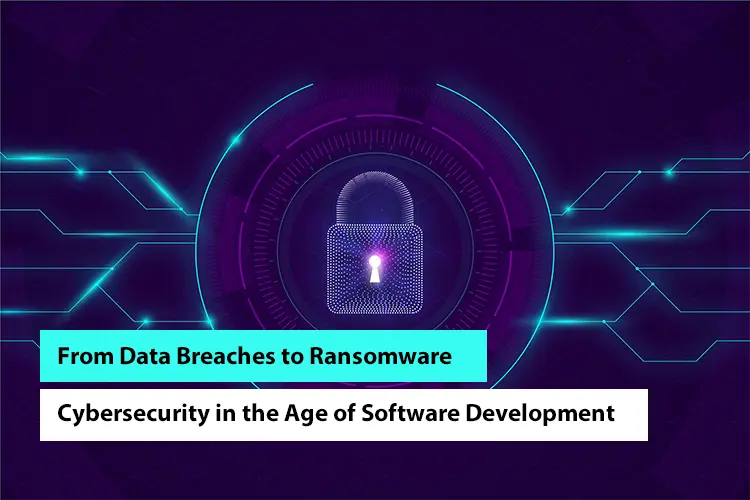From Data Breaches to Ransomware: Cybersecurity in the Age of Software Development

In today’s digital age, software development is more integral to our lives than ever before. From mobile apps to web platforms and even the Internet of Things (IoT), software powers the world around us. However, as offshore software development continues to evolve, so do the threats it faces. Cybersecurity is of paramount importance in this age, as data breaches and ransomware attacks have become all too common. This blog explores the challenges and best practices for cybersecurity in the age of software development.
The Evolving Threat Landscape
The landscape of cybersecurity threats is constantly evolving, shaped by technological advancements, changing attacker tactics, and the increasing interconnectedness of our digital world. Understanding the nuances of this evolving threat landscape is crucial for individuals, businesses, and governments as they seek to protect their digital assets and sensitive information. Let’s delve deeper into the key elements of this ever-shifting landscape:
Data Breaches
Data breaches have become a persistent concern for individuals, businesses, and governments. Attackers infiltrate systems and steal sensitive data, which may include personal information, financial records, or even classified government secrets. The fallout from a data breach can be catastrophic, leading to financial losses, reputational damage, and legal repercussions.
Ransomware
Ransomware attacks involve encrypting a victim’s data and demanding a ransom for the decryption key. The growth of ransomware attacks has been astronomical. Attackers often target critical infrastructure, healthcare institutions, and corporations. In 2021, the Colonial Pipeline ransomware attack disrupted fuel supply to the U.S. East Coast, highlighting the real-world consequences of these attacks.
Software Vulnerabilities
Software vulnerabilities are the weaknesses that attackers exploit. These vulnerabilities can exist in both off-the-shelf software and custom applications. As software continues to be developed and updated, new vulnerabilities may emerge, making ongoing security a necessity.
Also Read Our Blog: FinTech Cybersecurity – How to Build a Financial App with Proactive Security Measures?
Cybersecurity Challenges in Software Development

Cybersecurity challenges in software development represent a dynamic and multifaceted landscape that evolves alongside technological advancements and the ever-changing tactics of cybercriminals. These challenges are pivotal, as software underpins virtually every aspect of our modern lives, making it an attractive target for malicious actors. Here’s a more extensive exploration of the key cybersecurity challenges faced in the realm of software development:
Speed vs. Security Dilemma
The relentless demand for quicker software development often creates a conflict between speed and security. Under pressure to release features rapidly, hire offshore developers might inadvertently overlook security measures, potentially leading to the introduction of vulnerabilities. Balancing the need for agility with the necessity of robust security remains a significant challenge.
Supply Chain Attacks
The software supply chain has become a favored vector for cybercriminals. Attackers aim to compromise third-party software providers to gain access to the systems of their customers. This supply chain vulnerability can lead to widespread exploitation, making it crucial for organizations to rigorously vet their software providers and keep a watchful eye on software updates.
Zero-Day Exploits
Zero-day vulnerabilities, or security flaws unknown to both software vendors and the public, are a persistent threat. Cybercriminals actively seek these vulnerabilities, exploiting them before patches become available. Defending against zero-day exploits is a complex and ongoing challenge.
Human Error
Human error, from falling for phishing attacks to weak password practices and inadvertent data exposure, remains a significant threat. Attackers often capitalize on human vulnerabilities, making cybersecurity awareness training for all employees a critical countermeasure.
Legacy Systems and Outdated Software
Many organizations still rely on legacy systems and outdated software that may no longer receive security updates. These systems are attractive targets for cybercriminals due to their known vulnerabilities. Replacing or securing legacy systems is often a financial and logistical challenge.
Resource Limitations
Smaller organizations or startups with limited budgets and personnel may find it difficult to establish robust cybersecurity measures. This limitation can expose them to greater vulnerabilities due to inadequate resources for defense.
Third-Party Dependencies
Modern software development relies heavily on third-party libraries, frameworks, and APIs. These dependencies can introduce vulnerabilities if not managed carefully. Identifying and mitigating these risks pose additional challenges.
Regulatory Compliance
Different industries and regions are subject to varying degrees of regulatory compliance regarding cybersecurity. Staying current with these complex and ever-changing regulations requires ongoing effort and expertise.
To address these challenges effectively, organizations must adopt a multi-faceted approach that prioritizes security from the inception of software development. It involves integrating security into the development process, investing in employee training, continuously monitoring for vulnerabilities, and adhering to relevant compliance standards. In a landscape where cyber threats continually adapt and evolve, organizations must remain agile and proactive in their cybersecurity efforts to protect their software, data, and reputation.
Cybersecurity Best Practices in Software Development

Effective cybersecurity in software development is not an afterthought but a fundamental requirement. As software continues to evolve and cyber threats become more sophisticated, adopting a proactive and holistic approach to security is essential. Here are some comprehensive best practices to enhance cybersecurity in the software development process:
- Secure by Design: Security should be integrated from the very beginning of the software development process. This principle, known as “secure by design,” emphasizes that security should not be an added feature; it should be a foundational element. This means identifying potential security risks and threats during the design phase.
- Code Review and Testing: Regular code reviews and thorough testing are crucial for identifying and remediating potential vulnerabilities in software. Automated testing tools, static code analyzers, and dynamic application security testing (DAST) can assist in this process. Consider conducting security-focused code reviews in addition to standard code reviews.
- Patch Management: Promptly applying security patches and updates is vital to addressing known vulnerabilities. Implement a well-defined patch management process to ensure that updates are tested and deployed promptly. Vulnerability management programs can help identify and prioritize patches.
- Access Control: Implement strict access controls to ensure that only authorized personnel can access sensitive data and systems. Role-based access control (RBAC), least privilege access, and the principle of “need-to-know” are essential components of access control. Multi-factor authentication (MFA) should be used to enhance user identity verification.
- Encryption: Data encryption is essential for protecting sensitive information. Implement encryption at rest and in transit. This means encrypting data stored on disk and encrypting data while it is transmitted over networks. Strong encryption methods, such as Advanced Encryption Standard (AES), should be used.
- Security Awareness Training: Educating all employees about cybersecurity best practices is essential. Training should cover topics such as recognizing phishing attempts, practicing secure password management, understanding the risks of social engineering, and knowing how to report potential security incidents.
- Incident Response Plan: Develop and maintain a comprehensive incident response plan. This plan should outline roles and responsibilities, communication strategies, and detailed steps for containment, eradication, recovery, and lessons learned. Regularly test and update the plan to ensure its effectiveness.
- Red Teaming and Penetration Testing: Conduct regular red teaming exercises and penetration tests to identify vulnerabilities in systems and applications. Ethical hacking helps simulate real-world attack scenarios and assess the organization’s security posture. These tests should be performed by qualified professionals.
- Threat Intelligence: Stay informed about emerging threats and attack tactics through threat intelligence services. These services provide real-time information on the latest threats, enabling organizations to proactively adapt their defenses.
- Continuous Monitoring: Real-time monitoring of network traffic, user behavior, and system logs can help identify suspicious activities or security breaches early. Security information and event management (SIEM) systems are useful for aggregating and analyzing security data.
- Zero Trust Architecture: Zero Trust is an approach that assumes that threats exist both inside and outside the network. It verifies each user and device attempting to access resources, even if they are within the network. Implementing zero-trust principles helps protect against lateral movement by attackers.
- Secure Development Frameworks: Use secure development frameworks, libraries, and guidelines provided by reputable organizations. OWASP (Open Web Application Security Project), for example, offers guidance and tools for secure application development.
- Third-Party Dependency Management: Implement thorough dependency management practices. Continuously monitor for known vulnerabilities in third-party libraries and update them promptly. Tools like Software Composition Analysis (SCA) solutions can help with this.
- Automated Security Testing: Integrate automated security testing into the continuous integration and continuous deployment (CI/CD) pipeline. Tools like static application security testing (SAST) and dynamic application security testing (DAST) can be used to automatically scan code and applications for vulnerabilities.
- Compliance and Regulations: Stay informed about the industry-specific and regional regulations that apply to your organization. Ensure that your software development and security practices align with these requirements. Conduct regular compliance audits.
- Secure Supply Chain: Vet and monitor third-party software providers to ensure that they meet your security standards. Secure your software development and deployment pipeline to protect against supply chain attacks.
Conclusion
Cybersecurity in the age of software development is an ever-evolving challenge. With the growing threat of data breaches and ransomware attacks, organizations must prioritize security in their software development lifecycle. By embracing secure development practices, staying vigilant for vulnerabilities, and investing in cybersecurity training and technology, we can work together to safeguard our digital world and protect our sensitive data from falling into the wrong hands.
To fortify your organization’s cybersecurity and ensure your software development projects are protected, consider partnering with Imenso Software. Our team of experts can help you navigate the complex landscape of security in software development, offering comprehensive solutions and support. Don’t wait until it’s too late; make security a fundamental requirement from the very beginning. Get in touch with Imenso Software today to bolster your cybersecurity defenses and keep your digital assets safe.
We’re honored to mention that our efforts have been recognized by renowned B2B review and research platforms such as GoodFirms, Clutch, MirrorView, and many more.
Want more information about our services?
Similar Posts

Best Time Zones & Countries for Hiring Offshore Developers in 2025
All businesses are under constant pressure to be innovative, ranked, and remain competitive. Yet, having and managing an in-house development team is costly and time-consuming. This is most often observed in startups and mid-sized businesses. Scenarios like these are where offshore development occurs. It taps into global talent, cuts operating costs, and allows for 24/7 […]...

ReactJS and AR/VR: Exploring the Possibilities for Business Applications
Are you a business owner searching for innovative ways to captivate your audience and stay ahead in today’s competitive landscape? Do you find yourself pondering the possibilities of combining the power of ReactJS with the immersive realms of Augmented Reality (AR) and Virtual Reality (VR)? Look no further! In this blog, we delve into the […]...

The Role of Data in Feature Prioritization: Making Better Decisions
Have you ever had a problem deciding which of the many good features should be implemented in your software roadmap? It remains a challenge for many organizations. In the current world environment user requirements and technological changes are not consistent. A poor decision torments resources and opportunities. Contrarily, a correct decision can enhance user satisfaction […]...









